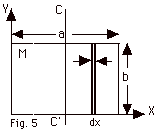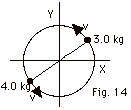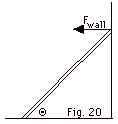|
|
|
1.
|
Write an expression for (a) the distance
x moved by a particle traveling with a constant linear velocity
v in time t and (b) the angle
Q moved by a particle rotating with a constant angular
velocity w in time t.
|
|
|
2.
|
Write an expression for (a) the constant
linear acceleration a of a particle going from linear velocity
vo at time t = 0 to a velocity v at time t and
(b) the constant angular acceleration going from angular velocity
wo at time
t = 0 to angular velocity w
at time t.
|
|
|
3.
|
Given that (a) dx/dt = v and a is constant,
find x(t) for an object initially at xo traveling
with vo at t = 0 and (b) dQ/dt
= w and a
is constant, find Q(t)
for an object initially at Qo
and rotating with wo
at t = 0.
|
|
|
4.
|
Starting from Qo=
0 and wo =
p s-1, a wheel
is given a constant angular acceleration of 4p
s-2. After 4.0 s find (a) its angular
speed and (b) how many turns the wheel has made.
|
|
|
5.
|
The angular position of a particle is
given by Q(t) = b + ct
+ et2, where b, c, and e are constants.
At time t1, the radial displacement of the
particle is r. Find (a) the angular velocity,
(b) the angular acceleration a,
(c) the linear velocity, (d) the tangential acceleration,
and (e) the centripetal acceleration of the particle at time
t = t1.
|
|
|
6.
|
Show that the direction, as well as
the magnitude of (a) the tangential velocity of a particle
moving in a circle of radius r drawn from the center
of the circle and rotating with angular velocity w
is v = w
x r and (b) the particle's radial or centripetal
acceleration is a = w
x (w
x r).
|
|
|
7.
|
The wheel shown in Fig. 1 below rotates
with constant angular velocity w.
Show that points 1 and 2 on the wheel move with the same angular
velocity, but different linear velocities. In Fig. 1, the
initial positions of the two points are shown by dark circles
and the positions at time t are shown with open circles. Point
1 is a distance r1 from the axis and Point 2 is
a distance r2 > r1 from the axis.

|
|
|
8.
|
Some of the particles that make up the
rigid body of a disk are shown in Fig. 2 below. (a) Write
a summation for the total kinetic energy of the disk with
particles from i = 1 to i = N in terms of the mass mi
of a particle and its velocity vi. (b) Substitute
the expression for the angular velocity w
of the disk in terms of vi and ri. (c)
Take the 1/2 and w out
of the summation and identify the quantity represented by
the summation. (d) Rewrite the kinetic energy in terms of
1/2, w, and the
quantity represented by the summation.

|
|
|
9.
|
Calculate the moment of inertia about
the Y-axis for a uniform plate of dimensions a x b with mass
M when the Y-axis coincides with an edge of the plate along
the b dimension, as shown in Fig. 3 below.

|
|
|
10.
|
Determine the moment of inertia of a
uniform solid sphere with radius R, mass M, and density r=
M/(4pR3/3),
about an axis through its center. Hint: Divide the solid
sphere into disks of thickness dy and radius x, as shown in
Fig. 4 below. Use the rotational inertia of a disk to find
the differential moment of inertia for the disk dI = 1/2 x2
dm.

|
|
|
11.
|
(a) Look at Fig. 3 above and Fig. 5 below
and decide whether the moment of inertia of the thin plate
is greater about the Y-axis or about the CC’ axis of
Fig. 5. (b) Calculate the moment of inertia by integration.
(c) Use the parallel axis theorem to determine the moment
of inertia about the CC’ axis.

|
|
|
12.
|
Find (a) A x B when A
= Axi + Ayj and B
= Bxi +
Byj and (b) the angle between A and
B.
|
|
|
13.
|
A massless string is wrapped around a
uniform solid cylinder with mass M = 30 kg and radius
R = 0.040 m. One end of the string is attached to the cylinder
and the free end is pulled tangentially by a force that maintains
a constant tension T = 3.0 N (Fig. 6 below). Find (a)
the angular acceleration and (b) the angular speed of the
cylinder 2.0 s after the force is applied to the cylinder
initially at rest.

|
|
|
14.
|
A massless string is wrapped around a
disk that has a radius R = 0.100 m and a mass M = 1.00 kg.
The free end of the string is attached to a hanging 0.500-kg
block; the other end is fixed to a point on the rim of the
disk (Fig. 7). Neglecting friction, find (a) the linear acceleration
of the hanging block and (b) the force exerted by the bearing
on the pulley. Take g = 10 m/s2.

|
|
|
15.
|
Show that the magnitude of the torque t
equals the product of (a) the force F times the component
of the distance r from the axis perpendicular to the
force F and (b) r and the component of F perpendicular
to r.
|
|
|
16.
|
A uniform rod of length L and mass M
is free to rotate about a frictionless pivot at the end attached
to the wall. The pivot is shown as a dark circle in Fig. 8
below. The rod is released from rest in the horizontal position.
Find the initial (a) angular acceleration of the rod
and (b) the linear acceleration of the right end of the rod.

|
|
|
17.
|
A uniform solid disk of radius R and
mass M is free to rotate on a frictionless pivot through a
point on its rim, as shown in Fig. 9 below. (a) If the disk
is released from rest in the position shown by the solid circle,
what is the velocity of the center of mass when it reaches
the position shown by the dashed circle? (b) What is the speed
of the lowest point on the disk in the dashed position? (c)
Repeat (a) and (b) for a uniform hoop.

|
|
|
18.
|
A solid disk of mass m is rolling along
a surface. Its center has velocity v. What is the kinetic
energy of the disk?
|
|
|
19.
|
A spool of wire of mass M and radius
R is unwound under a constant force F, as shown in Fig. 10
below. Find (a) the acceleration of the center of mass and
(b) the force of friction.

|
|
|
20.
|
A rigid body is made of three identical
thin rods, each with length L, fastened together in the form
of a letter H (Fig. 11 below). The body is free to rotate
about a horizontal axis that runs along the length of one
of the legs of the H. The body is released from rest in a
position where the plane of the H is horizontal. What is the
angular speed of the body when the plane of the H is vertical?

|
|
|
21.
|
A sphere of radius R rolls down an inclined
plane of height h and angle of inclination. Find (a)
using conservation of energy, the velocity of the center of
mass when the sphere is at the bottom of the incline and (b)
using Fnet = ma and tnet
= Ia, (i) the acceleration
of the center of mass, (ii) the frictional force that acts
on the sphere, and (iii) the speed of the sphere at the bottom
of the incline.
|
|
|
22.
|
A pencil of length L, initially standing
on end falls over. With what speed does the eraser strike
the horizontal surface, assuming the pencil point remains
at rest on the surface?
|
|
|
23.
|
A solid cylinder of mass M and radius
R rolls without slipping on a rough horizontal surface and
is accelerated to the right by a constant force F applied
at the cylinder's symmetry axis. Find (a) the acceleration
of the cylinder and (b) the force of friction on the cylinder.
|
|
|
24.
|
A uniform solid sphere with a mass M
= 2.0 kg and a radius R = 0.10 m is set into motion with an
angular speed wo
= 70 rad/s. At t = 0 the sphere is dropped
a short distance (without bouncing) onto a horizontal surface.
There is friction between the sphere and the surface. Find
(a) the angular speed of rotation when the sphere finally
rolls without slipping at time t = T and (b) the amount
of kinetic energy lost by the sphere between t = 0 and
t = T. (c) Show that the result in (b) equals the work done
against the frictional force that acts to cause the sphere
to roll without slipping.
|
|
|
25.
|
A small solid sphere of mass m and radius
r rolls without slipping along the loop-the-loop shown in
Fig. 12 below. Find (a) the minimum height h above the bottom
of the track you must release the sphere so that it will not
leave the track at the top of the hoop (assume the radius
of the loop-the-loop R >> r) and (b) the force of the
track on the sphere at P in Fig. 12 when it is released from
the height h found in (a).

|
|
|
26.
|
A particle of mass m moves in the xy
plane in a circular path of radius r. The motion of the particle
is counter-clockwise. Find (a) the magnitude and direction
of its angular momentum relative to the center of the circle
when its velocity is v and (b) an alternative expression for
L in terms of the angular velocity w.
|
|
|
27.
|
Show that the magnitude of the angular
momentum of a particle can be written as the product of (a)
the momentum of the particle p and the component of its position
vector r perpendicular to p and (b) r and the
component of its momentum p perpendicular to r.
|
|
|
28.
|
Find the direction and magnitude of the
angular momentum of the particle of mass m moving with velocity
v a distance r from the axis shown in Fig. 13
below.

|
|
|
29.
|
A light rod 1.0 m in length rotates
in the xy plane about a pivot through the rod's center. Two
particles of mass 4.0 kg and 3.0 kg are connected to its ends
(Fig. 14 below). Determine the angular momentum of the system
about the origin at the instant the speed of each is 5.0 m/s.

|
|
|
30.
|
Show dL/dt of a particle equals
the torque t acting
on it.
|
|
|
31.
|
A mass m is attached to a light cord,
which is wound around a pulley (Fig. 15 below). The pulley
is a uniform disk of mass M and radius R. Find (a) the net
torque on the system about the point O, (b) the angular momentum
of the system when the mass m has a speed v, and (c) the acceleration
of m using
dL/dt =t.

|
|
|
32.
|
A particle is launched with a velocity
vo at an angle of Q
with the horizontal as shown in Fig. 16 below. Find the angular
momentum of the particle about the origin when the particle
is (a) at the origin, (b) at its highest point, and (c) just
before it hits the ground. (d) What is the direction of the
change in angular momentum and what torques produces this
change?

|
|
|
33.
|
A particle of mass m and speed vo
collides with and sticks to the edge of a uniform solid
disk of mass M and radius R. If the disk is initially at rest
and pivoted about a frictionless axle through the center of
the disk, find (a) the angular velocity of the system after
the collision and (b) the loss of kinetic energy in the collision.
|
|
|
34.
|
A small particle of mass m moves with
velocity vo when it is a great distance from a
very large mass object that repels it. The potential energy
of the system is A/r, where A is a positive constant and r
is the distance between the two objects. Use conservation
of energy and angular momentum to find the minimum distance
dmin between the particle and the large mass
(Fig. 17 below) in terms of A, m, b, and vi.

|
|
|
35.
|
You exert a force F on the axle
of a spinning wheel (Fig. 18 below) to lift it. If the wheel
is spinning clockwise as you look at it, what happens to the
wheel. Explain your answer.

|
|
|
36.
|
Show only the direction of L changes
when t is
perpendicular to L.
|
|
|
37.
|
A wheel of mass m and moment of inertia
I relative to its axis is spinning with an angular velocity
w while the ends of the
axle are supported by two posts A and B, separated by a distance
2d and mounted on a rotatable platform (Fig. 19 below). At
what angular velocity (direction and magnitude) must the platform
be turned so that post B can be removed and the spinning wheel
still maintain a fixed position relative to the platform?

|
|
|
38.
|
A uniform ladder of length L and weight
W = 50 N rests against a smooth, vertical wall. The smoothness
of the wall means that the force due to the wall is horizontal
and to the right, as shown in Fig. 20 below. If the coefficient
of static friction between the ladder and ground is µs
= 0.40, find the minimum angle Qmin
such that the ladder will not slip.

|
|
|
39.
|
Solve Problem 24 above using conservation
of angular momentum.
|
|
|
40.
|
Two balls of mass M equal to 0.975 kg
are attached to the ends of a thin rod of negligible mass
which is 1.00-m long. The rod is free to rotate about a vertical
axis through it center. While the rod is horizontal (Fig.
22 below), a putty glob of mass m = 0.050 kg drops onto one
of the balls with a speed of 3.00 m/s and sticks to it. Find
(a) the angular speed of the system just after the putty glob
hits and (b) the angle through which the system rotates until
it momentarily stops. You may treat all the masses as point
particles. Take g = 10 m/s2.

|
|